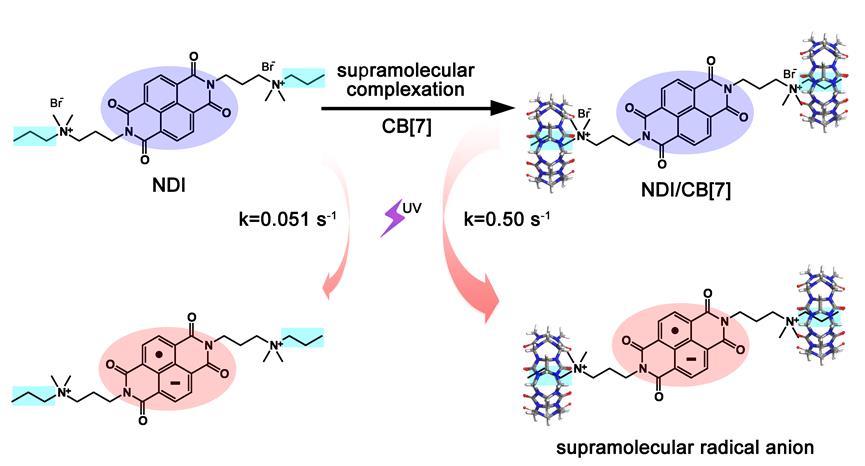Organic radicals are of great importance in the field of material science, such as paramagnetic materials and near infrared materials. However, due to their unpaired electron, most of the organic radicals are not stable enough, which limits their development greatly. It is still a challenge to fabricate stable organic radicals through a facile way.
Recently, Prof Xi Zhang and Prof Zhiqiang Wang’s research group from the Department of Chemistry, Tsinghua University, have established for the first time a supramolecular strategy to realize the fabrication of supramolecular radicals with satisfying stability. As shown in Figure 1, they attached cucurbituril molecules to each side of naphthalenediimide molecules through host-guest noncovalent interactions. Due to the electron-withdrawing effect of carbonyl groups on cucurbituril, the LUMO and HOMO energy level of naphthalenediimide was lowered significantly, thus promoting the photo-induced electron transfer process of naphthalenediimide. The production rate of the radical anions was accelerated by nearly 10 times, forming naphthalenediimide supramolecular radicals with extraordinary stability. It is anticipated that this supramolecular strategy may provide a new and facile way towards the stabilization of organic radicals. (See Chem. Sci., 2015, 6, 3342-3346)

Figure 1 Photo-induced electron transfer and the fabrication of supramolecular radicals
Based on the similar strategy, they also fabricated perylene diimide supramolecular radicals. The strong aggregation behavior of perylene diimide will lead to the quench of the corresponding radical anions. The introduction of cucurbituril suppressed its aggregation efficiently, thus improving the radical yield significantly. The formed perylene diimide supramolecular radicals exhibited characteristic absorption in the near infrared region. Compared to the perylene diimide radicals, the near infrared photothermal conversion efficiency of the supramolecular radicals was improved by nearly 100%, thus providing a new way to construct near infrared organic materials. (See Chem. Sci., 2015, DOI: 10.1039/C5SC01167A)